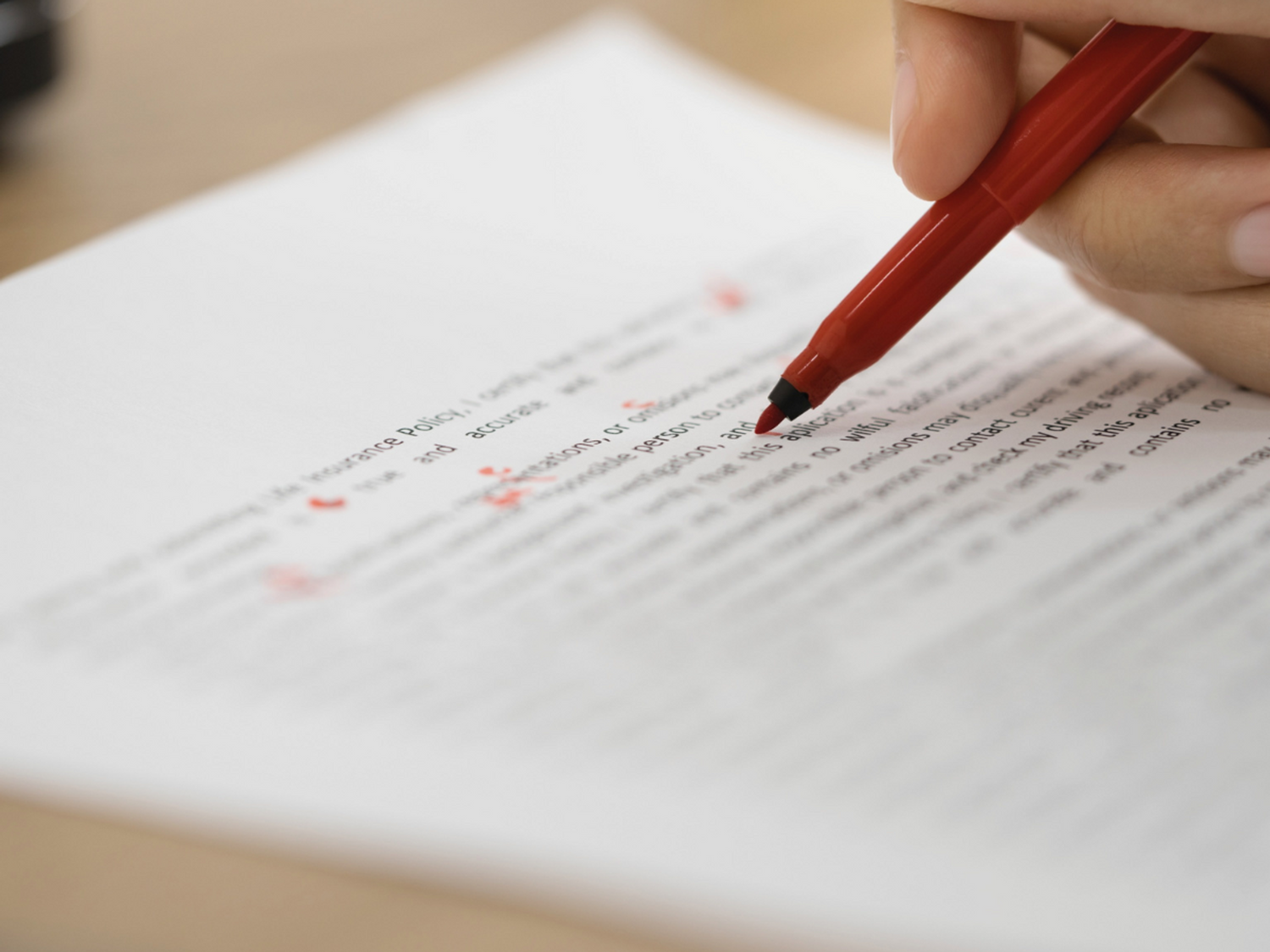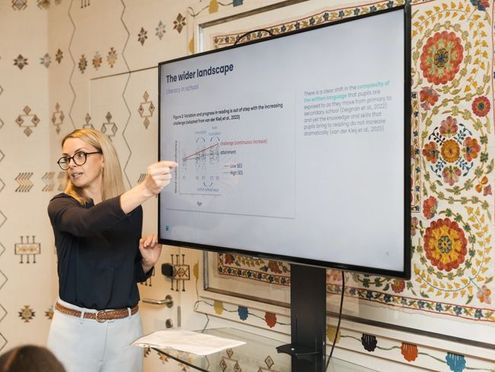Grammar is a system of rules based around a language. It sets a consistent framework for how we organise words to make it easier for us to communicate with each other. If everyone follows the same rules, it’s easier to express yourself, be understood, understand others and avoid misunderstandings. (Most of us have seen how let’s eat, Grandma changes to the more sinister let’s eat Grandma as a popular example of the power of the comma!)
Being able to communicate correctly and clearly is good for self-confidence and contributes to academic and career attainment.
We learn how to communicate through listening and speaking from a very young age - many of us absorb basic grammar rules without realising we’re doing it. Early on, we understand the difference between ‘I have a….’ and ‘Can I have a…?’, effortlessly rearranging sentence structure to achieve our goals.
It is only when we start to make a concerted effort to get to grips with more complex grammar that it can become challenging. The sheer volume of grammar in our bulging National Curriculum may seem overwhelming, and learners can become disheartened if they find themselves making countless grammar mistakes without understanding why.
For educators, too, grammar can be complicated. Due to our changing curriculum, some teachers were not taught grammar in school and have had to juggle teaching and learning simultaneously. Grammar still matters – but teachers are struggling to teach it; an article written by Willem Hollmann, a professor of Linguistics, recognises that there is a cohort of teachers who went to school at a time when the current robust approach to grammar was non-existent or in its infancy.
Hollmann believes learning grammar is about ‘gaining a broader understanding of one’s own language and how to use it creatively’. Focusing on creative outcomes widens the view of grammar beyond a set of rules that need to be learned and adds purpose. Ofsted’s report, Research review series: English, links linguistic features, such as sentence structure, with reading comprehension, an example of how grammar can deepen creative and literary experiences.
In his video on tips and advice for effective grammar teaching, educational expert Pie Corbett says that research suggests a formal teaching of grammar doesn’t necessarily lead to better reading and writing. To reap the wider rewards, we need to approach the teaching of grammar in a different way. He advises starting simply, so children get a feel for the grammar in practice before introducing grammatical terms and going on to deepen understanding. It should be a cumulative process, becoming more sophisticated as they go through school, and it should be taught in context and be purposeful. Using marking and identifying learners’ grammar mistakes give teachers opportunities to focus on what children find difficult, as well as running creative and playful sessions focusing on particular grammar rules.
In an increasingly technological and engagement-based world, the way learners interact with grammar as they progress is changing - the way we teach grammar must change also.
How can we playfully approach grammar basics?
Starting with grammar basics and mastering them through playful, purposeful and progressive practice can make learning grammar a more manageable and enjoyable process. The rules become useful tools in a toolbox that learners can dip in and out of as they move through the building blocks of learning and in later creative and literary experiences.
There are some grammar basics that need to be learned by rote - take plurals as an example. You add an s or es to the end of a noun to make it plural, but not always. There are exceptions with no discernible pattern.
Capitalisation is another example. It’s most common at the start of a sentence, but there are other specific uses that learners need to remember, such as days of the week or place names.
However, most of these basic grammar rules can be approached in a creative way that unlocks their potential, while grammar mistakes can be studied positively and playfully. Let’s examine a few.
Sentence structure
We know that a sentence should have the following elements:
- a capital letter at the start;
- terminal punctuation (a full stop, question mark or exclamation mark);
- a subject and a verb, plus an optional object; and
- the ability to make sense on its own.
A simple sentence follows the subject – verb – object pattern. The man chased the dog.
That simple sentence gives us a chance to play and to experience how sentence structure can impact on meaning. Swapping a few words makes a big difference. The dog chased the man. The dog is now the subject and the man the object, but even more notable is the change in the balance of power between the man and the dog.
A follow-on exercise could be to look at active and passive voice.
In the active voice, the subject is doing the action and the object is receiving it. The man chased the dog.
In the passive voice, the object is performing the action and the subject is receiving it. The sentence is reversed and the auxiliary verb ‘be’ (past tense ‘was’) and past participle are used. The dog was chased by the man.
Active and passive voice could be practised for different scenarios, adding context and purpose for the learner.

Parts of speech
These are the main word components that need to be put in a certain order to create meaning. They include:
- nouns – a person, animal, place or thing;
- verbs – an action or state of being;
- pronouns – a word used instead of a noun;
- adjectives – a word that describes a noun or pronoun;
- adverbs – a word that describes or adds meaning to a verb;
- prepositions – indicating the relationship between people or things, often referring to where they are; and
- conjunctions – used to link words and clauses.
As Pie Corbett points out, words only yield their meaning when used in a sentence and learners could be encouraged to play around with words that fall within multiple categories.
He uses ‘green’ as an example.
The apple is green. Here, it’s an adjective.
Let’s play on the green today. It has become a noun.
We are greening our cities. Now it is a verb.
Playing with words in this way could help learners absorb grammar rules more easily. As they progress, you could add new related rules. For example, add tenses to verbs to demonstrate how to convey time frames. Starting with the simple past and present tenses, I walk and I walked, the learner could progress through the different versions of the verbs and play with them. When would the continuous present tense, I am walking, or the perfect present, I have walked, be more appropriate?
Punctuation
This is the use of spaces and symbols to organise words in sentences and make them easier to read and understand. It can be used to impact the speed at which text is read and to add emotion, opening up opportunities for interactive and playful teaching.
Apostrophe
The apostrophe is an interesting punctuation mark as it has multiple uses - including to indicate possession or an omission of letters in a contraction – and getting them mixed up is a common grammar mistake.
Let’s look at possession. An apostrophe and an s are used together to show that a noun owns something. When the apostrophe comes before the s, it shows possession of a singular noun. The dog’s food.
When the apostrophe comes after the s, it indicates possession of a plural noun that ends in s. The dogs’ food.
Learners could play around with apostrophes and their positioning to see the impact on meaning. A quick search of the internet would throw up lots of misuses of apostrophes that educators could use to challenge their learners to identify grammar mistakes.
Colons and semicolons
One use of a colon is to connect a main clause with another clause, word or phrase. The text after the colon adds to or expands on the meaning of the text before the colon. Sabrina knew she had two choices: stay or run away.
A semicolon is used to join two main clauses that could be used on their own as sentences, but have a close relationship with each other.
Main clauses make sense on their own; joining clauses with a semi-colon indicates a connection between them.
Learners could practice pulling apart sentences to see the difference between colons and semi-colons, or use speech to hear the difference the pause associated with the punctuation makes. Moving forward, they might compare and contrast them with conjunctions, expanding their toolkit as they progress.
How Bedrock's grammar curriculum supports grammar instruction
From the basics of grammar to advanced grammar skills, Bedrock's grammar curriculum is designed to make learning fun and take the effort out of teaching grammar.
It immerses learners in engaging experiences, using stories, video, interactive activities and scaffolded writing opportunities, all of which are differentiated between primary and secondary learners. The rich curriculum helps students understand the outcome of different grammatical choices and improve written accuracy.
Aligned to the National Curriculum, our digital grammar curriculum teaches grammar in a contextualised and enjoyable way, helping learners achieve targets and communicate effectively in every subject across the curriculum.




